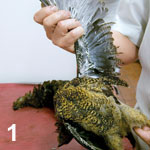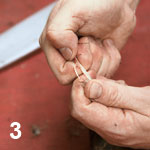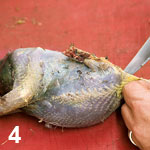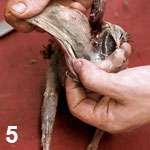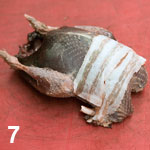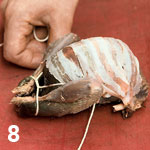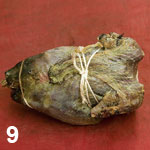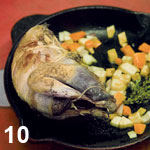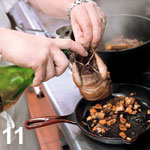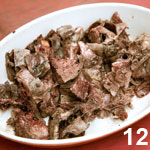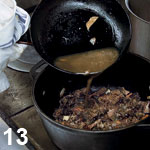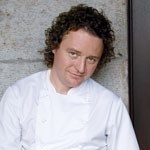Tom Kitchin masterclass: Grouse
With the shooting season now in full swing, up-and-coming Scottish chef Tom Kitchin shows Michael Raffael his method of cooking one of the more delicious and highly valued birds
In the first week of the grouse season this year Tom Kitchin sold 80 portions at £35 each. The Scottish chef could claim that the odds were stacked in his favour. The Edinburgh Festival and Fringe were in full swing, and supply was abundant. His reputation as a crusading proponent of Scotland's native produce doubtless helped.
Behind this headline success, the story is more beguiling still, however. Where many chefs buy oven-ready birds for convenience, he receives his freshly shot, with their plumage intact. Kitchin handles them carefully, ensuring that they eat better than more roughly butchered game birds.
Most chefs are content to roast the crowns and toss any other trimmings into the stockpot - they don't look beyond the obvious. Done this way, the meat may be tender and juicy, but will lack the succulence and depth of flavour of a whole bird.
Kitchin removes the tendons from the legs, an intrinsic part of his dish, and provides finger bowls for customers so they can pick them up by hand. He is thoughtful in the way he trusses each bird. Seasoning with a dash of brandy is done at the moment when it will improve the result.
The grouse season is short - from 12 August to 10 December. If not an endangered species, grouse are nevertheless a scarce luxury. Kitchin believes that he should show proper respect to every grouse that he prepares. By doing so, he helps to justify their hunting.
Tricks and traps of buying grouse
Expect to pay about £10 at cost price for a top-quality bird.
Modern chefs avoid hanging their feathered game. Wherever possible, order freshly shot grouse and use within a week
Choose young birds - only possible if they haven't been plucked and prepared in advance by the game dealer (1).
- The top of the head should be soft, although unscrupulous dealers have been known to crack the skull in order to trick customers.
- The fourth wing feather should be markedly shorter than those on either side of it.
- The claws should be flexible, as if they were double-jointed.
- The lower jaw of the beak should bend backwards without resistance or snapping.
What aren't visible on unplucked birds are shot or gun dog wounds in the prime flesh. If the chef has a good relationship with his supplier, he should be able to reclaim discounts on badly damaged ones. These can be used for stocks, soups, terrines, pies, pâtés and amuse-bouches.
Plucking
Plucking takes about five minutes per grouse, less with experience. Work with a bin liner for the feathers (2). Start at the tail end and work towards the neck and head. The feathers come out easily.
Leave the main wing pinions untouched. Don't fret too much about tearing the skin over the legs or breast, because it doesn't contribute to the flavour. However, pull off all the feathers on the neck as far as the grouse's head.
With a heavy knife, chop through the wing joints and discard the wings. Use a blowtorch to singe any remaining down or feathers.
Preparing
To remove the tendons from each leg, use a heavy-bladed knife to break the bone between the claw and the end of the "drumstick" (3).
Nip off the claws themselves. Hold the scaly end of the leg, twist and pull to extract the fibrous tendons. This step is essential if the leg is going to be served. It's impossible to do this on oven-ready birds.
Cut off the grouse's head, leaving the whole of the neck attached to the body. Lay the grouse breast down on the work surface. Slit the neck skin from the carcass to the point where it joins the head (4).
Fold back the skin to expose the gullet and crop. Discard these. The crop will contain heather on which the grouse has fed. If it still looks fresh, that's an indication of a recent kill (5). Leaving the skin over the neck attached to the carcass, cut off the neck. Cut around the V-shaped wishbone and pull it out, exactly as you would a chicken's (6).
Turn the bird on to its back again. Slit through the skin between the vent and the tip of the keel-bone. Insert two fingers inside the carcass and extract the innards. Take special care not to leave organs inside, which could make the grouse taste bitter.
Trussing
Season the inside of the carcass with salt and freshly ground black pepper.
Cover the breast with thinly sliced streaky bacon, about two rashers. This will be served to the customer, so choose a good-quality, preferably dry-cured one (7).
Truss the grouse firmly, but not too tightly, or it may give an impression of being roasted when it is either unevenly cooked or still raw.
Turn the grouse on to its side and pull the split neck skin over the backbone. Stand the bird breast uppermost, with the "parson's nose" towards you.
Slip the kitchen string underneath the tail end, bring it up, and fasten the string in a half-knot that pulls the exposed belly cavity together (8).
Slip the two ends of string behind the legs, between legs and breasts. Hold one end secure. Twine the other twice around the carcass, ensuring that it goes over the neck skin (9).
Lay the grouse on its side or breast and tie the two ends of string together. Refrigerate until just before service.
Roasting
This happens in three parts: the bird is seared on all sides on top of the range it's then roasted in a very hot oven and, finally, it's rested. If any of these phases is skimped, the grouse will probably be under-, or unevenly, cooked.
Ingredients
1 prepared grouse per serving
20ml neutral oil (sunflower, pomace)
50g mirepoix in small pieces (celeriac, carrot, shallots)
Sprig of fresh thyme
About 10ml - a good dash - brandy
Method
Make sure the grouse has been taken out of the refrigerator ahead of service so that it won't be chilled when roasted.
Heat the oil in a heavy-duty pan that will just contain the grouse. Lay the bird on one side of its breast and begin searing it. Turn it over on to the other side. Add the mirepoix and thyme (10). Turn it on to its back and continue to fry. By now, the bacon will have started to render some fat.
Hold up the grouse and sear the plump ends of the breast. Pour brandy inside the carcass (11).
Transfer pan and grouse to a preheated, very hot, oven (250°C). During service, oven temperature will fluctuate and affect cooking times marginally. Allow 12-15 minutes.
Rest the grouse at least five minutes before carving it.
If you stand it with its breast pointing upwards, the juices inside it will be better distributed.
Roast gravy
This has to be integrated into the kitchen's routine, because it's made from the carcasses after the grouse have been carved and served.
Carved carcasses from one service are stored under refrigeration overnight for turning into a sauce the next day. During this time they will render some juices flavoured with bacon, brandy and the mirepoix.
Allow two carcasses for about four generous portions of gravy, about 200ml.
Iingredients
2 grouse carcasses
30ml neutral oil
80g mirepoix in small pieces
Thyme
400ml well-flavoured chicken stock
60ml roasting juices
About 40ml red wine glaze (red wine and veal stock reduction)
Salt and pepper
Method
Chop the carcasses into walnut-sized pieces (12). Heat the oil in a heavy-duty saucepan. Brown the bones, mirepoix and thyme on top of the range.
Add a third of the stock and let it reduce to almost nothing (13). Repeat with a second third of stock and reduce. Add the last of the stock and let it reduce so that there is only a little liquid in the bottom of the pan. Add the roasting juices.
Strain the concentrated game jus into a small clean pan. Boil, add the red wine glaze and check the seasoning.
Serving and presentation
Kitchin follows the classic presentation of roast grouse - bacon, game chips, watercress, gravy and bread sauce.
Ingredients
1 roast grouse
1tbs cooked spinach
40g sautéd girolles and small chanterelles
1 heaped tablespoon pommes gaufrettes (fried at 170°C)
10g celeriac purée
30-40ml roast gravy
Separate accompaniment
Bread sauce
Bethod
Pull the bacon off the grouse and place on the plate. Carve both legs off the grouse and pare any skin on them. Carve the breasts off the grouse carcass, but leave the winglets behind. Pull the skin off the breasts. Separate the breasts and the fillets (14).
Place a small mound of spinach in the centre of the plate. Re-form the grouse around it. Lay the two breasts on the spinach with fillets on top. Put a leg on either side.
Arrange girolles, pommes gaufrettes and celeriac purée around the meat and finish with roast gravy. Accompany with a pot of bread sauce.
• Kitchin, who sees the legs as an intrinsic part of the dish, provides customers with a finger bowl so that they can pick them up by hand.
Bread sauce
(Makes enough for about six portions.)
Simmer 550ml unskimmed milk with two medium onions, each one stuck with a clove until the onion is tender.
Strain the milk into a clean pan and add 30g butter plus 30ml double cream. Whisk in 110g fresh white breadcrumbs until smooth.
Season with salt, white pepper and nutmeg or mace.
Tom Kitchin
It's just two years since Tom Kitchin opened his eponymous restaurant opposite the Scottish Executive building in Leith.
Within six months of opening, the chef, who calls Pierre Koffmann his mentor and who had worked two years for Alain Ducasse at the Louis XV in Monte Carlo, earned his first Michelin star.
Since then he has won Scottish Chef of the Year in 2007, and his restaurant, the Kitchin, was named as this year's Best Newcomer at the Cateys.
Wine selection
Kitchin's maître d' Philippe Nublat recommends a powerful Corbières, Château Haut-Gléon, Cuvée Chappert-Gaujal, 2005 (£12.95 per bottle from Edinbugh wine merchant Arts du Vin) to accompany grouse.
A 50-50 blend of Syrah and Grenache, it's a full-bodied ruby-tinted wine, with hints of blackberry and liquorice, matured in barrels for 12 months.



